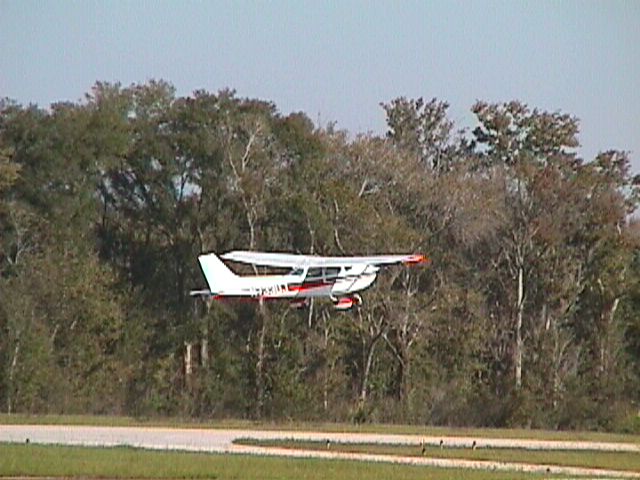 When
you first start, everything seems so complicated, but it gets familiar
pretty quickly so don't get discouraged. When
you first start, everything seems so complicated, but it gets familiar
pretty quickly so don't get discouraged.
First, you just
concentrate on the most basic control. You learn how to hold the
yoke, how to maintain level flight, and how to pitch for airspeed
and adjust RPM for altitude. You learn how to stear with your feet
for taxi work, and you start learning about the pattern.
Next, you learn
basic maneuvres like coordinated turns, climbing and descending
turns, and how to line up on the horizon, etc. After that, you'll
move on to turns around a fixed point, S-turns accross a road, slow
flight, and eventually, stalls. There are basically two kinds --
power off and power on. First, you put the plane into slow flight,
then, for power off stalls, you kill the power and pull the nose
straight up until it breaks into the stall. The objective is to
regain control and return to straight level flight while losing
as little altitude as possible. This is a very vulnerable time for
the airplane, because it can drop into a spin very easily in this
configuration. My first time, it started to fall off to the right,
so I stomped on the left rudder pedal and Bingo! into a spin we
went. The instructor pulled us right out and I got to see first
hand how to perform a spin recovery. The other kind of stall is
the power on stall. It is supposed to simulate a take-off stall,
but you will practice them at about 2500 feet for safety. This stall
is performed much the same as the power off stall, except that the
power is advanced to full befor the plane is put into the nose high
attitude. The stall is much more violent, and requires the pilot
to immediately reduce throttle, and neutralize the controls before
pulling out to level flight. You have to be able to do this within
200' of altitude to pass.
You will also
be learning how to land. People say that flying is the greatest
thrill known to man, but these people are not pilots. Pilots know
that flying is the SECOND greatest thrill known to man -- LANDING
is the greatest! You'll learn several different techniques to land
a plane, You'll learn about flaps, and slipping, and approach altitudes
and speeds and more. You will probably fly on at least one cross
country with your instructor during this time, and maybe even one
at night. I went to Venice at night, and man let me tell you that
it gets DARK out over the ocean at night. I went to Sebring for
lunch one day with my instructor when we were working on my first
cross country.
When
I was ready, I planned a trip to Avon Park Municipal, which was
about 53 NM away from Peter O'. Time for my first solo cross country.
I marked out my landmarks on my chart. I filled in my flight plan,
and set my avionics. I never even looked at my VOR the whole way,
but relied on dead recconning and pilotage to get there, and came
out on the other side within a couple of miles from where I was
supposed to. I landed on the short runway and had myself a soda
and calmed down for a few minutes before heading back. I was in
the 15o, and with the strong headwinds I had all the way back, I
figure my ground speed was about 50Mph. It got pretty bumpy on the
way back, and the little 150 got tossed around pretty good out there,
so I decided to step up to the 172's. I reasoned that it is easier
to find a rental 172 anywhere than it is to find a 150/152. It's
also harder than you might expect to get people to go up with you
in a plane that small.
My next milestone
was the long cross country. It has to be at least 150NM and at least
one airport on the trip has to be a minimum of 50NM away. Mine went
from Peter O' East to Sebring, back accross the state to Venice,
then back up to Peter O'. It was a much harder trip, and I was drained
afterward. I had trouble with the radio, and found out after I was
two thirds of the way through that my compass was wandering. I used
ground refferences and pilotage to navigate home.
After some more
hood work, which is where you are under a restrictive hood that
only allows you to see the gauges and nothing outside, you start
prepping for your practical exam. By now your instructor should
have identified any trouble areas for you and you should be concentrating
on them. You are almost ready at this point.
|

